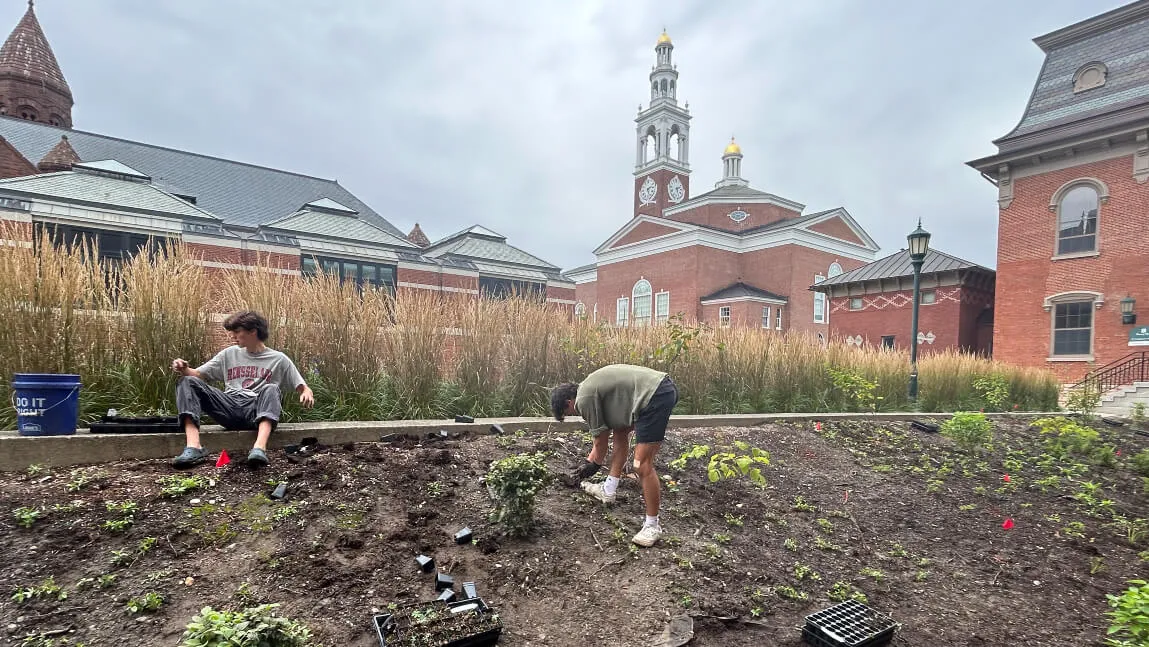On Earth Day, Office of Sustainability looks back on the year’s progress, including energy efficiency, investments in electric vehicles, and local food sourcing.
The University of Vermont’s Comprehensive Sustainability Plan (CSP), launched in 2023, outlines sustainability goals spanning from operations to academics. Since last year, UVM has seen measurable progress on several targets and the Office of Sustainability is excited to share several highlights with the campus community.
The CSP’s headline goal is carbon neutrality by 2030. UVM’s greenhouse gas emissions have been publicly reported since 2007. “In the last few months, we published an interactive tool detailing the University's emissions across 15 categories, from study abroad travel to solid waste, that helps us communicate our progress towards carbon neutrality,” said Caylin McCamp, acting Sustainability Director. “Advancing sustainability requires participation from all levels and corners of the University and this tool gives our community a clearer picture of the work that lies ahead.”
Investing in energy studies and efficiency measures. Stafford Hall was connected to chilled water from our Main District Energy Plant, replacing inefficient refrigerant coils. This project is expected to reduce electricity use by 610,000 kWh annually, and is comparable to the annual electricity consumption of about 90 Vermont homes. A separate boiler reprogramming project at the Main District Energy Plant was completed and is estimated to reduce our total building thermal emissions across campus by about 4%. Meanwhile, multiple energy studies are underway to identify effective measures for further reducing campus emissions from buildings.
Greening the UVM fleet and expanding electric vehicle (EV) infrastructure. Last year 10 more UVM fleet vehicles were electrified, bringing the total to 35. A new fleet permit fee was implemented as an incentive for vehicle owners to eliminate underutilized vehicles and make the switch from fossil fueled to electric powered vehicles (EVs). To accommodate the increase in EVs, UVM installed 56 additional charging ports, bringing the total to 92 ports on campus. Fifty more will be installed in the coming months at the BioResearch Complex and Wheeler House.
Increasing waste diversion options and studying new strategies. Multiple programs were expanded or improved, including residence hall composting and laboratory recycling. While the total amount of materials generated (recycling, compost and trash) decreased by over 220 tons, trash increased slightly. The results of a waste characterization study conducted in the fall will inform further waste reduction and diversion strategies.
Decreasing single use waste. UVM Dining Services launched a mobile app to improve access to and convenience of their reusable to-go container program, EcoWare. This mobile app increased participation in the program by 63%, saving 48,000 single-use containers and counting from entering the landfill. An impressive 98% of the reusable to-go containers were returned. This semester, UVM Dining launched EcoWare reuseable cups in 4 retail locations, further reducing the use of single-use items. UVM was the first public university to end the sale of bottled water in 2013 and this year solidified that successful commitment in University policy.
Sourcing local food. During the fall semester, UVM Dining spent $1,153,117 on local food (defined as foods grown or manufactured in Vermont), resulting in 20.9% of the food on campus being local. This represents a 5.4% increase over last academic year, putting UVM on track to meet the CSP goal of 25% local food by 2030.
Expanding campus gardens and electrifying maintenance equipment. Last summer, UVM planted approximately 3,000 square-feet of naturalistic gardens bordering the Votey and Lafayette buildings. These are low-maintenance beds of native plants that provide food and shelter for wildlife, attract pollinators, and retain water. In 2024, UVM purchased two electric mowers and 29 electric trimmers, blowers, saws, and shears, reducing dependance on fossil fuels for lawn maintenance and improving air quality for people enjoying campus grounds.
Aligning with Planetary Health Initiative. The CSP goals align strongly with UVM’s Planetary Health Initiative, launched last year to gather and strengthen institution-wide education, research, policy, outreach, and service at the intersection of human society and the natural environment. UVM’s Sustainable Solutions Lab now hosts an internship dedicated to increasing student engagement with and understanding of planetary health.
For more information, visit the CSP website.


